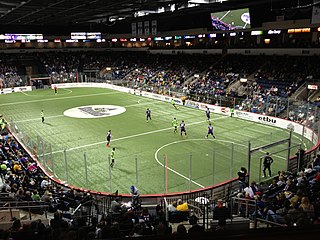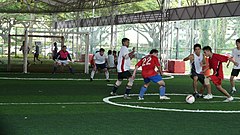
Association football, commonly known as football, or soccer, is a team sport played between two teams of 11 players each, who primarily use their feet to propel a ball around a rectangular field called a pitch. The objective of the game is to score more goals than the opposing team by moving the ball beyond the goal line into a rectangular-framed goal defended by the opposing team. Traditionally, the game has been played over two 45-minute halves, for a total match time of 90 minutes. With an estimated 250 million players active in over 200 countries and territories, it is the world's most popular sport.

Field hockey is a team sport structured in standard hockey format, in which each team plays with 11 players in total, made up of 10 field players and a goalkeeper. Teams must move a hockey ball around a field by hitting it with a hockey stick towards the rival team's shooting circle and then into the goal. The match is won by the team that scores the most goals. Matches are played on grass, watered turf, artificial turf, or indoor boarded surface.

Futsal is a football-based game played on a hardcourt like a basketball court, smaller than a football pitch, and mainly indoors. It has similarities to five-a-side football and indoor football.

Indoor soccer or arena soccer is a five-a-side or six-a-side version of minifootball, derived from association football and adapted to be played in walled hardcourt indoor arena. Indoor soccer, as it is most often known in the United States and Canada, was originally developed in these two countries as a way to play soccer during the winter months, when snow would make outdoor play difficult. In those countries, gymnasiums are adapted for indoor soccer play. In other countries the game is played in either indoor or outdoor arenas surrounded by walls, and is referred to by different names.
The Laws of the Game are the codified rules of association football. The laws mention the number of players a team should have, the game length, the size of the field and ball, the type and nature of fouls that referees may penalise, the offside law, and many other laws that define the sport. During a match, it is the task of the referee to interpret and enforce the Laws of the Game.
Socca is a team sports game with a ball, a variant of football in the 6x6 format.

Seven-a-side football is one of the minifootball variations of football, which is played among seven players in each team. In the game consists of one goalkeeper and six outfield players. The pitch of seven-a-side football is bigger than that of five-a-side football, ranging from 50-65 yards in length and 25-50 yards in width respectively.

Cageball is a sport invented by the football coach Jörg Berger in October 2002, seeking a way to play association football despite bad winter conditions.

Football is a family of team sports that involve, to varying degrees, kicking a ball to score a goal. Unqualified, the word football normally means the form of football that is the most popular where the word is used. Sports commonly called football include association football ; Australian rules football; Gaelic football; gridiron football ; International rules football; rugby league football; and rugby union football. These various forms of football share, to varying degrees, common origins and are known as "football codes".
Mini football may refer to:

Association football was first codified in 1863 in England, although games that involved the kicking of a ball were evident considerably earlier. A large number of football-related terms have since emerged to describe various aspects of the sport and its culture.
The following outline is provided as an overview of and topical guide to association football:

Amputee football is a disabled sport played with seven players on each team. Outfield players have lower extremity amputations, and goalkeepers have an upper extremity amputation. Outfield players use loftstrand (forearm) crutches, and play without their prosthesis.

Comparison of association football (football/soccer) and rugby union is possible because of the games' similarities and shared origins.

The World Minifootball Federation (WMF) is highest global authority for 6-a-side, with 5 a-side, 7 a-side, 8 a-side, and arena soccer disciplines version of minifootball. WMF exists to promote, supervise and direct minifootball growth. Its members are worldwide national minifootball teams and continental minifootball federations.

Minifootball is a small-sided variation of football.

Futsal began in the 1930s in South America as a version of association football, taking elements of its parent game into an indoor format so players could still play during inclement weather. Over the years, both sports have developed, creating a situation where the two sports share common traits while also hosting various differences.
Omegaball is a variation of association football in which three five-a-side teams play in a simultaneous competition with each other on a circular pitch that is 60 yards in diameter. The distance from each goal to the center location is roughly 30 yards. Each team has a goal to protect, and the goals are evenly distributed along the perimeter of a circular field.















